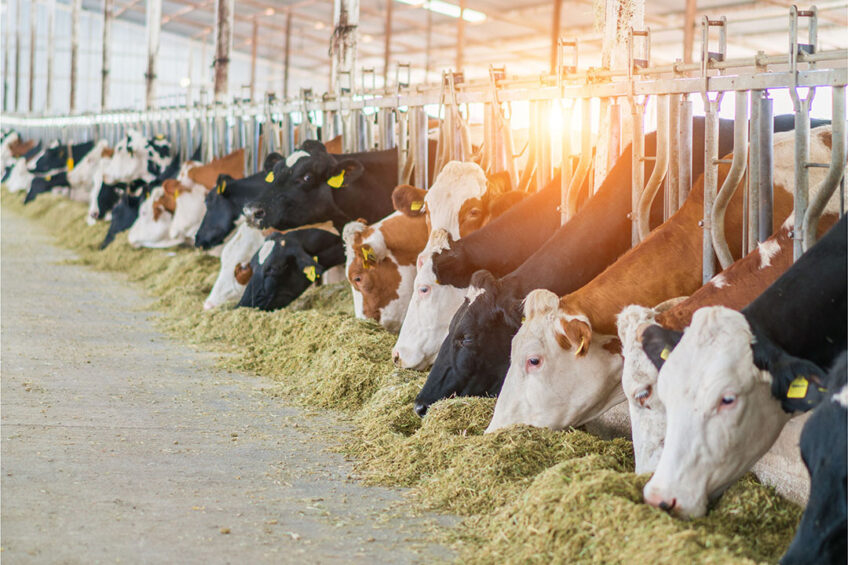Early-warning tool to evaluate subacute ruminal acidosis

Faecal sampling is a non-invasive method to evaluate faecal characteristics and microbiota to monitor subacute ruminal acidosis.
Subacute ruminal acidosis (SARA) is a highly prevalent digestive disorder in high-producing dairy herds. Early lactation is a period of increased subacute ruminal acidosis risk; therefore, identifying animals at risk during the dry period is crucial. Subacute ruminal acidosis impacts the rumen and hindgut bacterial communities. Thus, faecal sampling is a method to evaluate faecal characteristics and microbiota to monitor SARA.
Consequences of subacute ruminal acidosis
Subacute ruminal acidosis, or chronic or sub-clinical acidosis, is a multifactorial disorder commonly caused by diets containing a high proportion of fermentable carbohydrates and low levels of physically effective fibre. Subacute ruminal acidosis has multiple impacts on dairy cows, including a decrease in rumen function, incomplete degradation of fermentable carbohydrates in the rumen and small intestine, reduction in hindgut pH, higher risk of hindgut acidosis and diarrhoea, and alteration in the rumen and hindgut microbiota.
In addition, subacute ruminal acidosis reduces feed intake, impairs cow health, and causes high rates of involuntary culling. Reduced fibre digestibility and increased volatile fatty acids such as propionate cause feed intake reduction. Furthermore, a decrease in rumen pH (below 6.0) reduces the number of acid-sensitive fibrolytic rumen bacteria.
On the other hand, reduction in rumen pH induces the release of vasoactive substances, such as histamine and lipopolysaccharide endotoxin of bacterial origin. The vasoactive substances impair the capillaries of the lamellae in the foot, causing haemorrhage, inflammation, laminitis, and lameness in dairy cows. Other consequences of subacute ruminal acidosis include a decrease in milk yield, milk fat production, and milk protein production by 2.7 kg/day, 0.3% points and 0.12% points, respectively.
Moreover, the translocation of rumen bacteria such as Fusobacterium necrophorum and Arcanobacterium pyogenes to the portal blood due to decreased barrier function of the rumen mucosa leads to liver abscesses in cases of subacute ruminal acidosis.
Dairy cow faecal characteristics
The potential biomarkers of subacute ruminal acidosis in dairy cow faeces include faecal pH, fermentation metabolites such as volatile fatty acids, and microbial profiles. Faecal pH in healthy dairy cows follows a biorhythmic pattern and it varies throughout the day, showing distinct patterns in response to factors such as diet, dry matter intake, feeding management, and stress.
Volatile fatty acid is produced through the fermentation process in the gut and supplies energy to dairy cows. Faecal microbiota comprises protozoa, archaea, bacteria, and fungi representing a complex ecosystem and factors such as housing type, dietary components, and cow characteristics affect faecal microbiota composition.
Impact of subacute ruminal acidosis
In the case of subacute ruminal acidosis, a large amount of undigested feed escapes from the rumen and small intestine. It causes extensive fermentation in the hindgut, which, in turn, enhances the acidity of the hindgut contents and faeces. Hindgut acidosis damages gut epithelial cells and leads to epithelial cells shedding in the large intestine, which in turn leads to diarrhoea.
Furthermore, an increase in readily fermentable carbohydrates in the dairy cow diet initially leads to an increased growth rate of most rumen bacteria, stimulates fermentation by hindgut bacteria, and produces more volatile fatty acids such as acetate, butyrate, and propionate. Within the pH ranges between 5.6 and 6.0, the fermentative capacity and growth rates of lactic acid-producing bacteria, such as Streptococcus bovis and lactic acid-utilising bacteria, such as Megasphaera elsdenii are in equilibrium.
However, as the fermentation proceeds and the absorptive capacity of the rumen papillae are reached, the rumen pH decreases due to increases in total volatile fatty acid rather than lactic acid. These changes in rumen pH alter the structure of the microbial community in the rumen and hindgut, reduces the number of cellulolytic bacteria, increase the number of pathogenic bacteria such as Gram-positive cocci and rods and Gram-negative bacteria, and compromise dairy cow health and productivity.
Rumen pH depression below 5.6 for more than 3 hours per day increases free lipopolysaccharide in rumen fluid. It enhances the breakout of Gram-negative bacteria depending on the diet and rumen bacterial population in case of subacute ruminal acidosis. For example, corn-based diets with high amounts of readily fermentable starch result in higher numbers of E. coli in the rumen. A decline in rumen pH increases osmotic pressure and damages rumen epithelium depending on the quantity of carbohydrates consumed and its fermentability.
The aforementioned activities damage rumen barrier function, degrade gap junctions and tight junctions of the rumen epithelial tissue and predispose the ruminal lining to transport of endotoxin and absorption of biogenic amines.
Conclusion
Subacute ruminal acidosis is a multifactorial digestive disorder generally caused by diets containing a high proportion of fermentable carbohydrates and low levels of physically effective fibre in high-producing dairy herds. Subacute ruminal acidosis affects rumen function, reduces hindgut pH, alters rumen and hindgut microbiota, reduces feed intake, and leads to diarrhoea, haemorrhage, inflammation, laminitis, lameness, and liver abscess in dairy cows.
In addition, subacute ruminal acidosis alters faecal characteristics and compromises dairy cow health, welfare, and production performance. Therefore, faecal sampling provides a non-invasive early-warning method to evaluate and monitor this disorder across the dairy herd. Although further study is required to investigate changes in the structure of the hindgut microbial community during subacute ruminal acidosis to set up a robust evaluation method.






